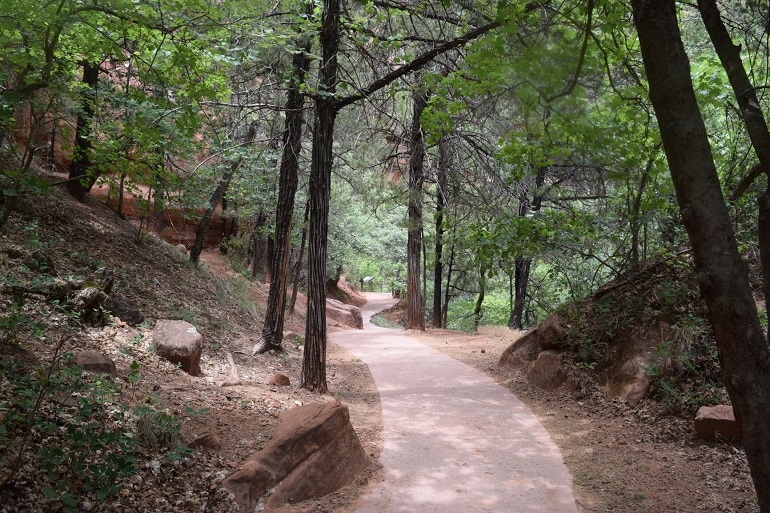A recent trip to Zion National Park inspired RIck Yelton to write about the beauty and restfulness of nature, especially when combined with concrete pathways designed using the new RMC Foundation Guide to Concrete Trails.

Health professionals have been urging us to take an outdoor stroll. These outings combine exercise, the feeling of openness, and the beauty of nature to help deal with stress. The benefits are outlined in “In Praise of Walking: A New Scientific Exploration,” by Shane O’Mara, a professor of experimental brain research at Trinity College, Dublin. Outdoor experiences are meant to be more than goal-driven activities of reaching 10,000 steps or closing activity rings.
O’Mara writes that fellow researchers have quantified the medical benefits from even a 15-minute outdoor walk. Attention restoration theory says when humans experience the natural world, it markedly assists in maintaining and fostering a strong sense of well-being.
Earlier this month, my family conducted our own attention restoration therapy while visiting Zion National Park. For two days, we trekked many of Zion’s iconic trails. Nearing the end of our visit, I urged everyone to take one final stroll citing that it was important as part of my job as a spokesman for concrete. My family just rolled their eyes when I suggested, “What better way to end our vacation?”
The reason I was so insistent was that I wanted to experience the craftsmanship of the concrete and masonry used to restore Zion’s popular Lower Emerald Pool Trail that had just opened. The project was funded by the Zion National Park Forever Project.
In time, the project will enable the reopening of historic sections of both the Lower Emerald Pools Trail and the Middle Emerald Pools Trail and restore visitor access to the full Emerald Pools Trail complex for the first time in nearly a decade. The Project estimates that nearly 2 million visitors will be able to experience attention restoration therapy on the reopened trails by dispersing visitor use in this section of Zion Canyon.
The project is a model of how concrete and masonry can play an important role in providing a resilient and sustainable stewardship. From the selection of integrally colored concrete, to the use of masonry retaining-wall structures, the average visitor is not distracted from Zion’s beauty. Of course, I primarily took pictures of the concrete pathway.
The concrete and masonry industry has a fantastic opportunity to promote our products as the key material for trails, bikeways, and paths. Congress is moving toward a rare bipartisan effort to pass a massive funding bill to rehabilitate our national parks and monuments (the Great American Outdoors Act). I hope that other parks will be able to follow Zion’s Emerald Pool trail upgrades.
Fortunately, we now have a valuable new resource to help promote our products in the parks. Earlier this year, the RMC Foundation published “The Guide to Concrete Trails.” Written by the National Concrete Pavement Technology Center, the guide provides design professionals, decision makers, practitioners, and public agencies with advice on the design, construction, and maintenance of concrete trails and paths. The guide offers information for construction of all types of paved recreational trails and construction methods. You can download the entire guide by clicking here and share it with your customers and design professionals.
In these unsettling times, it’s appropriate to share good feelings. World of Concrete would like to create a gallery of your favorite concrete pathways on which you have practiced attention restoration therapy. So, I’m inviting you to share these restful locations with our World of Concrete community. Post your images and tell us a story on why this is your favorite concrete pathway via Facebook or Instagram using the #WOC360News and tag us at @worldofconcreteshow. We will post this gallery in an upcoming newsletter.
About the Author(s)
You May Also Like




